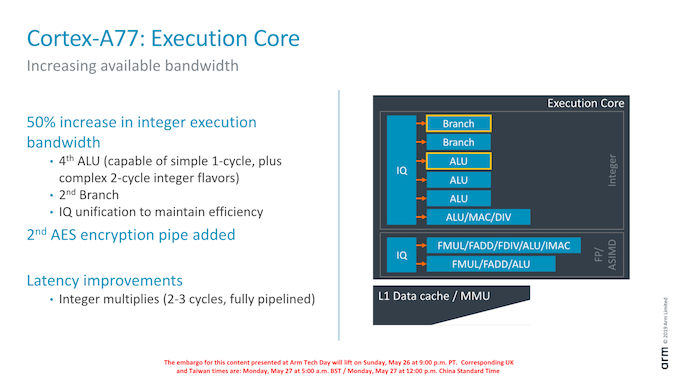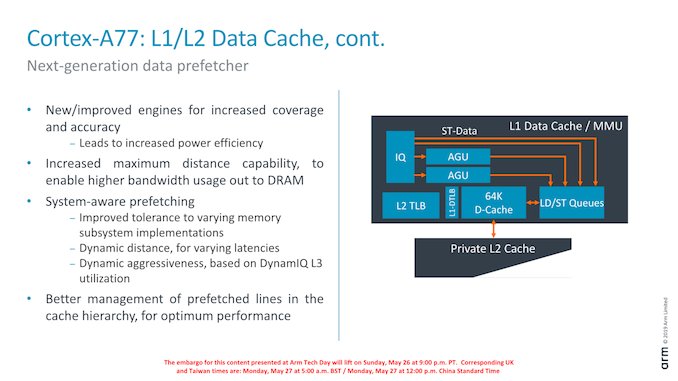Arm's New Cortex-A77 CPU Micro-architecture: Evolving Performance
by Andrei Frumusanu on May 27, 2019 12:01 AM ESTThe Cortex-A77 µarch: Added ALUs & Better Load/Stores
Having covered the front-end and middle-core, we move onto the back-end of the Cortex-A77 and investigate what kind of changes Arm has made to the execution units and data pipelines.
On the integer execution side of the core we’ve seen the addition of a second branch port, which goes along with the doubling of the branch-predictor bandwidth of the front-end.
We also see the addition on an additional integer ALU. This new unit goes half-way between a simple single-cycle ALU and the existing complex ALU pipeline: It naturally still has the ability of single-cycle ALU operations but also is able to support the more complex 2-cycle operations (Some shift combination instructions, logical instructions, move instructions, test/compare instructions). Arm says that the addition of this new pipeline saw a surprising amount of performance uplift: As the core gets wider, the back-end can become a bottleneck and this was a case of the execution units needing to grow along with the rest of the core.
A larger change in the execution core was the unification of the issue queues. Arm explains that this was done in order to maintain efficiency of the core with the added execution ports.
Finally, existing execution pipelines haven’t seen much changes. One latency improvement was the pipelining of the integer multiply unit on the complex ALU which allows it to achieve 2-3 cycle multiplications as opposed to 4.
Oddly enough, Arm didn’t make much mention of the floating-point / ASIMD pipelines for the Cortex-A77. Here it seems the A76’s “state-of-the-art” design was good enough for them to focus the efforts elsewhere on the core for this generation.
On the part of the load/store units, we still find two units, however Arm has added two additional dedicated store ports to the units, which in effect doubles the issue bandwidth. In effect this means the L/S units are 4-wide with 2 address generation µOps and 2 store data µOps.
The issue queues themselves again have been unified and Arm has increased the capacity by 25% in order to expose more memory-level parallelism.
Data prefetching is incredibly important in order to hide memory latency of a system: Shaving off cycles by avoiding to having to wait for data can be a big performance boost. I tried to cover the Cortex-A76’s new prefetchers and contrast it against other CPUs in the industry in our review of the Galaxy S10. What stood out for Arm is that the A76’s new prefetchers were outstandingly performant and were able to deal with some very complex patterns. In fact the A76 did far better than any other tested microarchitecture, which is quite a feat.
For the A77, Arm improved the prefetchers and added in even new additional prefetching engines to improve this even further. Arm is quite tight-lipped about the details here, but we’re promised increased pattern coverages and better prefetching accuracy. One such change is claimed to be “increased maximum distance”, which means the prefetchers will recognize repeated access patterns over larger virtual memory distances.
One new functional addition in the A77 is so called “system-aware prefetching”. Here Arm is trying to solve the issue of having to use a single IP in loads of different systems; some systems might have better or worse memory characteristics such as latency than others. In order to deal with this variance between memory subsystems, the new prefetchers will change the behaviour and aggressiveness based on how the current system is behaving.
A thought of mine would be that this could signify some interesting performance improvements under some DVFS conditions – where the prefetchers will alter their behaviour based on the current memory frequency.
Another aspect of this new system-awareness is more knowledge of the cache pressure of the DSU’s L3 cache. In case that other CPU cores would be highly active, the core’s prefetchers would see this and scale down its aggressiveness in order to possibly avoid thrashing the shared cache needlessly, increasing overall system performance.













108 Comments
View All Comments
Thala - Friday, May 31, 2019 - link
For Windows it is a ecosystem and user perception problem. Many users and review websites expect ARM needs to beat x86 using x86 emulation to be viable - which is totally unrealistic. Instead they need to point out that ARM is already on level playing field regarding IPC with latest Intel/AMD cores while using significantly less power when they run proper native Win32 apps.In particular these new A77 cores should be able to trump Zen2 and Icelake when it comes to IPC.
adamo1139 - Wednesday, May 29, 2019 - link
Will you be covering Mali G77, which I think debuted with A77 according to ARM blog? OT: How I should pronounce Arm? Like an arm the limb or A.R.M?adamo1139 - Wednesday, May 29, 2019 - link
Nevermind, I haven't seen that you already covered that lolRaqia - Monday, June 3, 2019 - link
Thanks for your continued updates and excellent benchmarking work. I take it we won't see a >= 6-wide design until after Hercules?ChrisGX - Thursday, June 6, 2019 - link
"Arm promises energy efficiency of the A77 will remain the same as current-gen A76 SoCs."I do get the concern about elevated power usage while processing workloads but is that statement formally correct? Isn't the point of ARM's claims for its new chip that you get more work done for the same energy input? So, that means improved energy efficiency, unless I have missed something. The efficiency gain, in this case, doesn't take the form of a reduced rate of depletion of the battery but the reduced time it takes to complete processing workloads.
Andrei certainly is right that the increased power draw of these new chips at peak performance is a real drawback. While processor designers must be after step improvements in that relationship - with peak performance maintained while knocking down power usage - no such improvements seem to be forthcoming in lieu of a silicon process shrink. And, even then, the improvements are pretty modest.
Javert89 - Sunday, June 9, 2019 - link
Andrei as middle core in4+2+2confivs is the A77 better or A76 still a best option for middle?AlyssaPatterson - Wednesday, June 26, 2019 - link
Very well explained latest information about Arm’s new cortex- A77 CPU micro-architecture: Evolving performance. I am impressed with your post. I must say thank you for sharing wonderful update about CPU.- Alyssa
http://www.secureassignmenthelp.com/economics-assi...
alysdexia - Monday, December 30, 2019 - link
What is wrong with Anandtech? Can't even report spam.